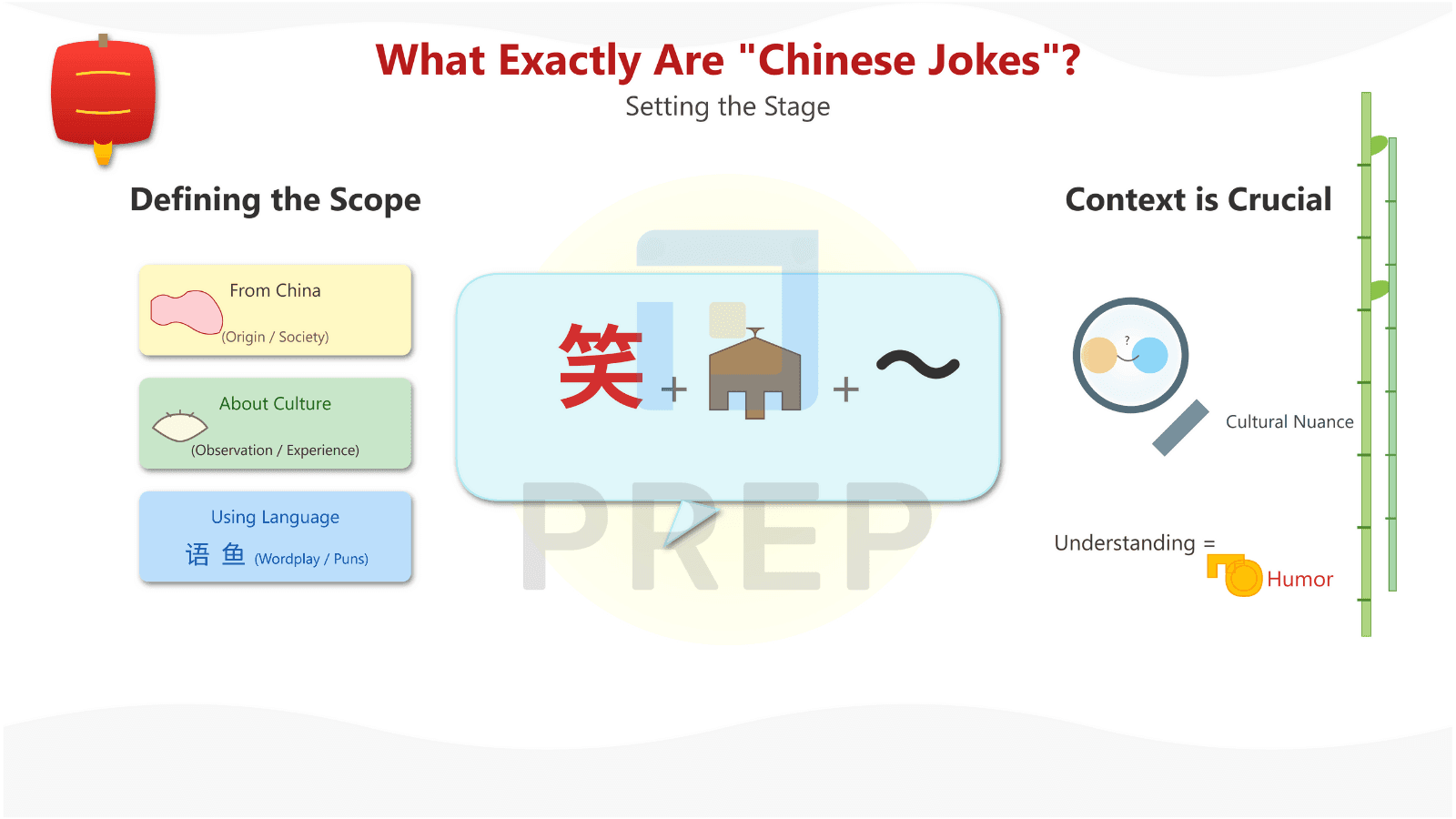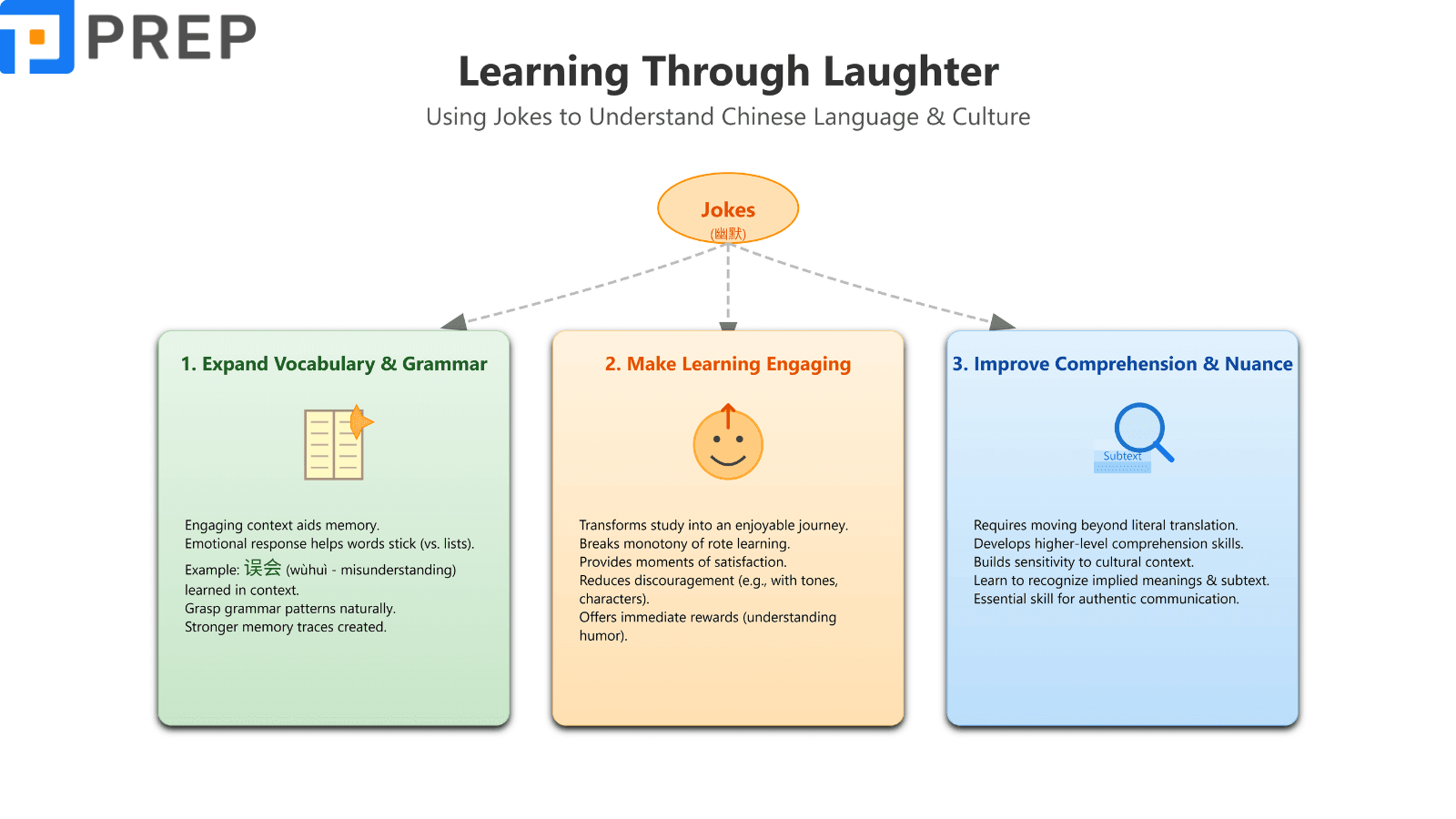Unpacking Chinese Jokes: A Guide to Humor, Culture, and Language
Laughter transcends boundaries, yet understanding humor across cultures presents a fascinating challenge that reveals deeper insights about language and society. Chinese jokes offer a window into a rich cultural landscape where wordplay, shared experiences, and historical context converge to create distinctive forms of comedy. This comprehensive guide explores the multifaceted world of Chinese jokes—from authentic humor originating in China to cross-cultural observations and language-based wit—going beyond simple joke collections to unpack the mechanisms and meanings behind the laughter.
- I. What Exactly Are "Chinese Jokes"? Setting the Stage
- II. Exploring Different Flavors of Chinese-Related Humor
- III. Learning Through Laughter: Using Jokes to Understand Chinese Language & Culture
- IV. The Importance of Sensitivity: Laughing With, Not At
- V. Deepening Your Understanding: Related Questions Answered
- 1. What is "Xiangsheng" (相声) or Chinese Crosstalk comedy?
- 2. What are common themes found in modern Chinese online jokes?
- 3. How does humor aimed at native Chinese speakers differ from jokes intended for language learners?
- 4. Is it generally considered acceptable for non-Chinese individuals to share jokes about Chinese culture?
- VI. Beyond the Punchline: Appreciating Cultural Nuance and Finding More Resources

I. What Exactly Are "Chinese Jokes"? Setting the Stage

1. Defining the Scope: Jokes From China, About Chinese Culture, or Using the Language?
When exploring Chinese jokes, clarity about what this term encompasses proves essential for meaningful understanding. The category spans several distinct types: jokes created within Chinese society and originally expressed in Chinese languages, observational humor about Chinese cultural practices or experiences, and wordplay that leverages the unique linguistic features of Mandarin or other Chinese dialects. This diversity reflects China's vast regional variations, generational differences, and historical contexts—from traditional teahouse comedy to contemporary social media memes.
2. Why Context is Crucial: Understanding Humor Across Cultures
The challenge of appreciating Chinese jokes stems from how deeply humor embeds itself in cultural and linguistic frameworks. Direct translations often fail to capture the essence because the comedic elements frequently depend on specific cultural references, linguistic structures unique to Chinese, or shared social experiences. Jokes on Chinese culture often value subtle wordplay enabled by the language's abundance of homophones, contextual nuances that communicate unspoken meanings, and observations that gently comment on social dynamics. Developing awareness of these underlying mechanisms transforms seemingly basic jokes into revelations about Chinese cultural values and communication patterns.
II. Exploring Different Flavors of Chinese-Related Humor
1. Translated Laughs: Jokes from China Explained
Understanding authentic Chinese jokes requires navigating the complexities of translation while preserving the original context. The following examples demonstrate different styles of humor popular within Chinese society, with explanations to bridge the cultural gap.
1.1. Example 1: The Geography Teacher
Chinese: 地理老师:"同学们,请问太平洋的水能带回家吗?" 学生:"不能,太远了。" 老师:"错,答案是太平洋的水太多了,带不完。"
Pinyin: Dìlǐ lǎoshī: "Tóngxuémen, qǐngwèn Tàipíngyáng de shuǐ néng dài huí jiā ma?" Xuésheng: "Bù néng, tài yuǎn le." Lǎoshī: "Cuò, dá'àn shì Tàipíngyáng de shuǐ tài duō le, dài bù wán."
Translation: Geography teacher: "Students, can you bring Pacific Ocean water home?" Student: "No, it's too far away." Teacher: "Wrong, the answer is that the Pacific Ocean has too much water to carry completely."
Vocabulary:
-
地理 (dìlǐ) - geography
-
太平洋 (Tàipíngyáng) - Pacific Ocean
-
带回家 (dài huí jiā) - bring home
Explanation: This joke plays on expectation subversion, a common element in Chinese classroom humor. The humor arises from the teacher's pedantic focus on the literal impossibility of the task (too much water) rather than the practical constraint (distance) identified by the student. This reflects a comedic take on the sometimes rigid question-answer format in traditional Chinese education, where teachers might expect specific responses regardless of alternative valid answers.
1.2. Example 2: The Smart Parrot
Chinese: 一位妇女买了一只鹦鹉。店主说:"这只鹦鹉很聪明,会说话。" 一周后,妇女回来抱怨说:"这只鹦鹉一句话也不说!" 店主说:"它不说话不代表它不聪明,它在思考呢。"
Pinyin: Yí wèi fùnǚ mǎi le yì zhī yīngwǔ. Diànzhǔ shuō: "Zhè zhī yīngwǔ hěn cōngmíng, huì shuōhuà." Yī zhōu hòu, fùnǚ huílái bàoyuàn shuō: "Zhè zhī yīngwǔ yí jù huà yě bù shuō!" Diànzhǔ shuō: "Tā bù shuōhuà bù dàibiǎo tā bù cōngmíng, tā zài sīkǎo ne."
Translation: A woman bought a parrot. The shopkeeper said, "This parrot is very smart and can talk." A week later, the woman returned complaining, "This parrot hasn't said a word!" The shopkeeper replied, "Not talking doesn't mean it's not smart—it's thinking!"
Vocabulary:
-
鹦鹉 (yīngwǔ) - parrot
-
聪明 (cōngmíng) - smart
-
思考 (sīkǎo) - thinking
Explanation: This joke showcases the classic structure of commercial deception followed by clever justification. The humor lies in the shopkeeper's quick-witted rationalization that transforms a defect (a non-talking parrot) into a superior feature (a deeply contemplative bird). This reflects the Chinese cultural appreciation for quick thinking and verbal dexterity, particularly in commercial contexts where saving face remains important for both parties.
1.3. Example 3: The Helpful Doctor
Chinese: 病人:"医生,我只有半分钟的生命了,快救救我!" 医生:"请等一下,我先看看别的病人。" 一小时后,医生回来了。病人愤怒地说:"你说我只有半分钟生命,为什么让我等了一小时?" 医生笑着说:"看,我救了你,你现在好多了!"
Pinyin: Bìngrén: "Yīshēng, wǒ zhǐyǒu bàn fēnzhōng de shēngmìng le, kuài jiùjiù wǒ!" Yīshēng: "Qǐng děng yíxià, wǒ xiān kànkan biéde bìngrén." Yī xiǎoshí hòu, yīshēng huílái le. Bìngrén fènnù de shuō: "Nǐ shuō wǒ zhǐyǒu bàn fēnzhōng shēngmìng, wèishénme ràng wǒ děng le yī xiǎoshí?" Yīshēng xiàozhe shuō: "Kàn, wǒ jiù le nǐ, nǐ xiànzài hǎo duō le!"
Translation: Patient: "Doctor, I have only half a minute to live. Please save me!" Doctor: "Please wait, I'll check on other patients first." An hour later, the doctor returns. The patient angrily says: "You said I only had half a minute to live, why did you make me wait an hour?" Doctor smiles: "See, I saved you. You're much better now!"
Vocabulary:
-
半分钟 (bàn fēnzhōng) - half a minute
-
生命 (shēngmìng) - life
-
救 (jiù) - to save
Explanation: This hilarious Chinese joke employs situational irony and highlights the doctor's unconventional "treatment" through neglect. The humor emerges from the doctor reframing his negligence as a brilliant cure, turning the patient's survival into proof of successful treatment rather than evidence that the diagnosis was wrong. This reflects a type of absurdist humor that gently satirizes authority figures while acknowledging the universal experience of healthcare frustrations.
2. Observing the Culture: Humor in Everyday Life & Cross-Cultural Interactions
Chinese jokes often draw from everyday experiences and social observations that reveal cultural values and norms. Popular themes include family dynamics—particularly relationships between generations where traditional values encounter modern practices. Food-related humor highlights the central importance of cuisine in Chinese culture, from regional rivalries to the sometimes extreme lengths people go to for authentic flavors. The navigation of social hierarchies, face-saving practices, and the balance between individual desires and collective expectations also provide rich material for observational comedy.
Cross-cultural jokes often emerge from moments of cultural collision, where different expectations create humorous misunderstandings. For Chinese individuals living abroad or foreigners in China, these observations transform potential frustrations into shared laughter about the challenges of adapting to unfamiliar systems. Visual artists like the creator of "Tiny Eyes Comics" capture these nuanced cultural differences through illustrations that communicate both humor and deeper understanding of cross-cultural experiences. The best of this humor builds bridges rather than reinforcing stereotypes, finding common ground in shared human experiences viewed through different cultural lenses.
3. Wordplay Wonders: Puns and Linguistic Humor
The structure of Mandarin Chinese creates exceptional opportunities for wordplay due to its tonal nature and abundance of homophones. Words that sound identical except for tone differences, or completely identical sounds with different characters and meanings, form the basis for countless puns. For example, the number four (四, sì) sounds similar to death (死, sǐ), creating various funny Chinese jokes playing on this unfortunate similarity. Similarly, the word for fish (鱼, yú) sounds like the word for surplus or abundance (余, yú), making fish dishes symbolic of prosperity and generating numerous puns, especially around New Year celebrations.
English wordplay involving Chinese concepts typically relies on simpler mechanisms like phonetic similarities. Examples include jokes on Chinese pronunciation, such as "wok-ing" instead of "walking," or someone being "China" find something (trying to find). While these china jokes often fall into the category of lighthearted "dad jokes," they represent accessible entry points for cross-cultural humor that doesn't require advanced language knowledge. Unlike authentic Chinese puns that operate within the language's internal logic, these jokes highlight the phonetic bridges between languages and call attention to the distinctive sounds of Chinese words within English contexts.
III. Learning Through Laughter: Using Jokes to Understand Chinese Language & Culture

1. Benefit 1: Expanding Vocabulary and Grasping Grammar Naturally
Chinese jokes provide an engaging context for language acquisition that transcends rote memorization. The emotional response to humor creates stronger memory traces, helping vocabulary stick more effectively than isolated word lists. When you encounter terms like 误会 (wùhuì - misunderstanding) within a humorous scenario, the word becomes associated with both its definition and the emotional response it triggered, creating multiple retrieval pathways in memory.
2. Benefit 2: Making Language Learning More Engaging and Less Tedious
Incorporating humor transforms the sometimes overwhelming process of language learning into a more enjoyable journey. Jokes for Chinese language learners create moments of satisfaction that break the monotony of study while still advancing language skills. This approach particularly benefits learners who might otherwise become discouraged by the challenges of mastering tones or character recognition, providing immediate rewards through understanding and appreciating the humor.
3. Benefit 3: Improving Reading Comprehension and Cultural Nuance
Understanding Chinese jokes requires progressing beyond literal translation to grasp implied meanings, cultural context, and subtle wordplay. This challenges you to develop higher-level comprehension skills that apply across all language use. The effort invested in decoding humor builds sensitivity to cultural nuances, teaching you to recognize when a statement carries unspoken implications or cultural subtext—an essential skill for authentic communication in any language context.
IV. The Importance of Sensitivity: Laughing With, Not At

1. Recognizing the Fine Line
A crucial distinction exists between humor that celebrates cultural uniqueness and jokes about Chinese people that reduce individuals to simplistic stereotypes. Chinese jokes should emerge from genuine understanding and appreciation rather than perpetuating harmful caricatures based on appearance, accent, or oversimplified cultural traits. The difference often lies in whether the humor recognizes complexity and humanity or flattens individuals into one-dimensional representations.
2. Role of Intent, Context, Respect
The appropriateness of humor depends on the relationship between speaker and audience, the setting in which jokes are shared, and the underlying intention behind the comedy. Respect forms the foundation of acceptable cross-cultural humor—respect for individuals' dignity, cultural heritage, and lived experiences. Context also matters significantly; jokes appropriate among friends familiar with each other's boundaries differ from those suitable for public settings or professional environments.
3. Our Commitment
This guide commits to presenting Chinese humor in ways that promote understanding and appreciation while avoiding content that could reasonably cause harm. We recognize the power of comedy to either bridge or divide cultures and aim to demonstrate how humor, when approached thoughtfully, builds connections through shared laughter and deeper cultural awareness.
V. Deepening Your Understanding: Related Questions Answered
1. What is "Xiangsheng" (相声) or Chinese Crosstalk comedy?
Xiangsheng represents one of China's most distinctive traditional comedic art forms, typically performed by two comedians engaged in rapid-fire dialogue filled with wordplay, witty banter, and comedic storytelling. Dating back over a century, this performance style demands exceptional verbal dexterity, perfect timing, and deep cultural knowledge. Modern xiangsheng often blends traditional techniques with contemporary references, maintaining its essence of linguistic virtuosity while addressing current social themes that resonate with today's audiences.
2. What are common themes found in modern Chinese online jokes?
Contemporary Chinese internet humor frequently revolves around workplace pressures, relationship challenges in modern society, and the contrast between traditional expectations and modern realities. Tech-related china jokes about online shopping addictions, social media behaviors, and delivery service dependencies reflect China's rapid digital transformation. Self-deprecating humor about study pressure, housing costs, and career competition provides catharsis for common social stresses. These themes connect through their reflection of a society experiencing rapid change while maintaining connections to traditional values.
3. How does humor aimed at native Chinese speakers differ from jokes intended for language learners?
Native-oriented Chinese jokes assume comprehensive cultural knowledge, employ sophisticated wordplay with multiple meaning layers, and often reference current events or trending internet phrases without explanation. In contrast, humor designed for language learners typically features simplified vocabulary, explains cultural references explicitly, and often highlights specific language points being studied. Learner-focused jokes for Chinese students might deliberately incorporate recently taught grammar patterns or vocabulary, serving dual purposes of entertainment and reinforcement of language concepts.
4. Is it generally considered acceptable for non-Chinese individuals to share jokes about Chinese culture?
Non-Chinese individuals can appropriately share humor related to Chinese culture when it demonstrates genuine understanding, avoids reinforcing harmful stereotypes, and comes from a place of appreciation rather than mockery. The reception depends heavily on the joke's substance—whether it shows recognition of cultural complexity or relies on oversimplified assumptions. Context also matters significantly; jokes shared among friends familiar with each other's intentions differ from public performance or social media sharing where intentions may be less clear and potential for misinterpretation higher.
VI. Beyond the Punchline: Appreciating Cultural Nuance and Finding More Resources
1. Key Takeaways: Humor as a Window, Not Just a Joke
Chinese jokes offer far more than momentary amusement—they provide insights into linguistic structures, cultural values, and social dynamics that might otherwise remain inaccessible to outside observers. The diversity within Chinese humor reminds us that no culture produces monolithic expressions but rather complex variations reflecting regional differences, historical contexts, and individual creativity. Understanding these jokes deepens appreciation for both the specific cultural elements they contain and the universal human experiences they often highlight.
2. Where to Find More Authentic & Respectful Humor
For those seeking to explore Chinese humor further, several reliable sources provide content that balances authenticity with accessibility. Look for comedians who thoughtfully discuss cultural identity and cross-cultural experiences, such as Joe Wong, who successfully bridges Chinese and American comedic traditions. Language learning platforms often include culturally-rich humor sections that provide appropriate context alongside jokes. Culturally-focused websites and social media accounts curated by Chinese creators often share hilarious Chinese jokes that resonate across cultural boundaries while maintaining authenticity.
3. Final Thoughts: Connecting Through Shared Laughter and Understanding
The journey through Chinese jokes ultimately reveals how humor serves as a universal language while simultaneously reflecting distinct cultural patterns. When approached with curiosity, respect, and willingness to understand contextual nuances, these jokes transform from potentially confusing phrases into meaningful cultural exchanges. By learning to appreciate the mechanisms behind Chinese humor—whether linguistic cleverness, social observation, or situational irony—you develop not just language skills but deeper cross-cultural understanding that extends far beyond the punchline.

Hi I'm Chloe, and I am currently serving as an Product Content Administrator at Prep Education. With over five years of experience in independent online IELTS study and exam preparation, I am confident in my ability to support learners in achieving their highest possible scores.
Comment
Premium content
View allPersonalized roadmap
Most read












